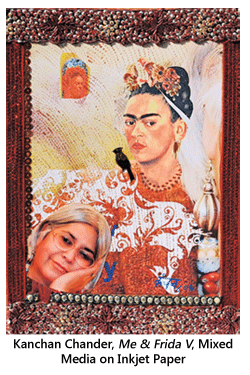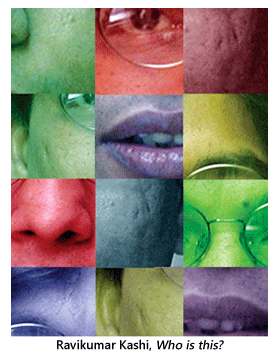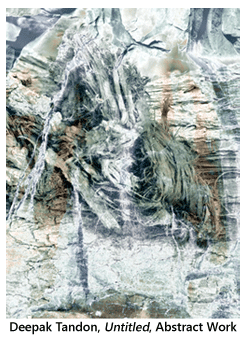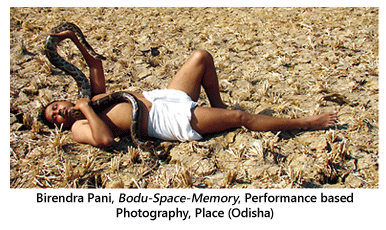- Publisher's Note
- Editorial
- Sixteen printmakers talk about their work
- The Imprinted Body
- A Chai with Vijay Bagodi
- The Wood Engravings of Haren Das
- A Physical Perception of Matter
- Feminine Worlds
- A Rich Theater of Visuality
- A Medley of Tradition
- Decontextualizing Reality
- Printmaking and/as the New Media
- Conversations with Woodcut
- Persistence of Anomaly
- Sakti Burman - In Paris with Love
- Lalu Prasad Shaw: The Journey Man
- Future Calculus
- A Note on Prints, Reproductions and Editions
- A Basic Glossary of Print Media
- The Art of Dissent: Ming Loyalist Art
- Vishnu: Hinduism's Blue-Skinned Savior at the Brooklyn Museum of Art
- Twelfth edition of Toronto International Art Fair
- Vintage Photographs of the Maharajas
- Göteborg International Biennial
- A Museum, a Retrospect & a Centenary for K.K. Hebbar:
- Recent and Retrospective: Showcase of Shuvaprasanna's Work
- "I Don't Paint To Live, I Live To Paint": Willem de Kooning
- Salvador Dali Retrospective: I am Delirious, Therefore I am
- To Be Just and To Be Fair
- Census of Senses: Investigating/Re-Producing Senses?
- Between Worlds: The Chittaprosad Retrospective
- Awesomely Artistic
- Random Strokes
- Counter Forces in The Printmaking Arena and how to Counter them
- Shift in focus in the Indian Art Market
- What Happened and What's Forthcoming
- Art Bengaluru
- Mumbai Art Sighting
- Musings from Chennai
- Art Events Kolkata
- Previews
- In the News
ART news & views
Decontextualizing Reality
Volume: 4 Issue No: 21 Month: 10 Year: 2011
Feature
Behind the rationale of digital prints
by Dr. Seema Bawa
 Digi-graph or Giclee is the new buzzword in town. A number of artists are incorporating digital prints into their works either in part or independently. Lithographs, flexographs, serigraphs and other works printed with traditional methods are giving way to digital printing. Artists generally use inkjet or laser printing to make reproductions of their original two-dimensional artworks, photographs, or to create computer-generated art. The works form part of an emerging paradigm in technology (cloud-computing), business (derivatives) as well as aesthetics, involving commoditization, virtualization, integration and innovation.
Digi-graph or Giclee is the new buzzword in town. A number of artists are incorporating digital prints into their works either in part or independently. Lithographs, flexographs, serigraphs and other works printed with traditional methods are giving way to digital printing. Artists generally use inkjet or laser printing to make reproductions of their original two-dimensional artworks, photographs, or to create computer-generated art. The works form part of an emerging paradigm in technology (cloud-computing), business (derivatives) as well as aesthetics, involving commoditization, virtualization, integration and innovation.
The difference between digigraphy and traditional methods such as lithography, flexography, gravure, or letterpress is that no printing plates are used, resulting in a quicker and less expensive process. The most popular methods include inkjet or laser printers that deposit pigment or toner onto a wide variety of substrates including paper, photo paper, canvas, glass, metal and marble. The scope for experimentation is immense in digital prints. One can experiment at the time the image is captured in digital memory and then again experiment through computer manipulation and experiment even further after the image has been transposed onto a displayable surface.  Thus in terms of treatment, a digital print stretches photography beyond conventional frontiers.
Thus in terms of treatment, a digital print stretches photography beyond conventional frontiers.
It is no wonder that artists are using digital technology in their works. Birendra Pani recalls that a number of students at Baroda started using new technologies to transfer photographs from newspapers and other sources on to litho plates to create more contextualized images. Many of these artists went on to form a group "New Mediatic Realism" with Pani, Riyaz Komu, Chintan Upadhyay and others as members. The group interacted with photographic images and incorporated these into their works directly or after manipulation. Thus they explored a new visual language using mediatic prints. Photography is central to the creative process that leads to new media prints. “I photograph various elements of nature for their abstract visuals and begin using transformation technique; bringing out liquid in solid or fire in liquid or solid, creating interplay between the elements", says Deepak Tandon, “The bark of a tree could give an impression of a wave in a river or maybe sometimes fire. These are sometimes stitched together, using the roller principle as used in my paintings.  Thereafter colour is modified to enhance the essence of the image within, while leaving the original visual structure intact.”
Thereafter colour is modified to enhance the essence of the image within, while leaving the original visual structure intact.”
Each of these artists has a valid but different reason for choosing digital print technique over traditional printing technique. One of the original members of Indian Printmakers Guild, Kanchan Chander, who has turned to new media printmaking after working with lithography and woodcut for years says, “Traditional printmaking has its own charm but one cannot deny that it is laborious, and somewhat limiting. One has to physically go to a specially equipped workshop. For digital prints I can work on Photoshop from my home. Most importantly I can play with the images, juxtaposing and superimposing images and mediums which is not possible with traditional prints.”
The nature of his visual concerns impelled Sandeep Biswas towards digital work. As he explains, “The primary reason to choose this medium is the immense possibilities to experiment with work context and thoughts. Technically I could get much closer to what I wanted to express. The choice of paper and canvas is far superior to the availability of such media earlier. If I have editions of any work, then the perfection and consistency of the print is greater.” Deepak Tandon explicates on this further, “Primarily being an abstract painter, I experimented with the photographic medium a few years back. The behaviour of various elements of nature,  their interaction, alteration, interdependence on each other on one hand and the existence of similarities and symmetries on the other, coupled with elements such as fire, solid in liquid, in opposition and in complementariness, urged me to create an illusion, or deconstruct the natural through the digital process.”
their interaction, alteration, interdependence on each other on one hand and the existence of similarities and symmetries on the other, coupled with elements such as fire, solid in liquid, in opposition and in complementariness, urged me to create an illusion, or deconstruct the natural through the digital process.”
Digital imagery is the method that allows some artists to go on to create a new vocabulary. For Kanchan Chander the digital medium allows her to express more, as the limitations of technicalities are removed from the process. In today's fast world the far less time-consuming use of technology frees her for more experimentation. Sandeep Biswas elaborates, “My work is metaphorical and is based on surreal imagery. Digitalization has served the purpose of dealing with subjects and context that I express and it helps me enhance the same. Areas of exploring the image are greatly widened because of the numerous possibilities that the medium offers.” The chain between camera, computer, computer application and printer is used differently by each artist. Kanchan takes the photographic image and works with it in Photoshop and then uses the print as the surface on which she embellishes with sequins, crystals and glitter. One can see this in her Frida and Me series where she has used the images of Frida Kahlo and her own self in various permutations and combinations. On the other hand, Pani avoids Photoshop, not allowing for any intervention between the original image, preferring the “mystery of reality" to permeate his prints. His photographs of capsules in pink and green are a case in point.
Ravikumar Kashi traces four distinct ways in which he uses digital technology in his work. First, he creates images in Photoshop. While some of these are created using only the tools available in the program, others involve using photographs or images scanned from his collection as a source. Later these images are elaborately worked upon in the system. Secondly, he uses Photoshop as a tool to work out the preparatory stage of his paintings. Here the digital device is a visualizing tool to explore various possibilities  before embarking on actual painting. Thirdly, he makes use of digital photography extensively to create a collection of images and as a standalone medium. Lastly, he generates digital images that become the base layer for further work in mediums like watercolour, pastels or even collage. For the first two processes that use Photoshop and for digital photographs he takes prints on archival paper using inkjet printing technologies. These are planned as limited editions of three to six prints. He also uses images printed on paper, canvas, aluminum, flex, wood or cloth to explore different surfaces. He then works on these printed images so they end as unique works.
before embarking on actual painting. Thirdly, he makes use of digital photography extensively to create a collection of images and as a standalone medium. Lastly, he generates digital images that become the base layer for further work in mediums like watercolour, pastels or even collage. For the first two processes that use Photoshop and for digital photographs he takes prints on archival paper using inkjet printing technologies. These are planned as limited editions of three to six prints. He also uses images printed on paper, canvas, aluminum, flex, wood or cloth to explore different surfaces. He then works on these printed images so they end as unique works.
“The digital medium to me is like a tool that gives me the freedom to break out of conventionalism and beyond the physicality of a print. It gives me the freedom to interpret and reinterpret. It helps enhance my expression through a metaphorical approach rather than limiting me to the realism that photography is associated with. Though it has immense technical possibilities, one needs to understand where to limit oneself, so that expression is communicated without creating a visual complexity,” says Biswas. In spite of the popularity of digital printing and its permeation in the art practices of today, one must add that not all digitally created works are cutting-edge works or aesthetically valuable. “Digital is only a new media tool like any other art form that helps one's language and expression.  A lot depends on how intelligently one deals with the medium, rather than just creating a visual chaos, terming it a digital image. Aren't all art forms a manipulated form of imagery?” cautions Biswas.
A lot depends on how intelligently one deals with the medium, rather than just creating a visual chaos, terming it a digital image. Aren't all art forms a manipulated form of imagery?” cautions Biswas.
Given the technological advances of today, artists prefer to use archival ink on archival paper that not only allows for deeper and truer colours but also gives the print longevity beneficial to collectors. Digital technology has also allowed for the creation of accurate series of reproductions of two-dimensional artworks. The self imposed restriction of taking an edition of five to six prints of course adds to the value of the prints. But perhaps the greatest value added by digigraphy is the creation of a new aesthetics in contemporary art: a post globalization 'conceptual art' with a new visual language. Digigraphy first contextualizes the elements of aesthetic works and then decenters or decontextualises the same under a creatively novel aegis.